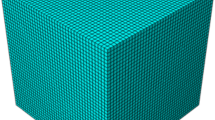Abstract
The mechanical behavior of open-cell foams may be modeled either on a microscopic or a macroscopic scale. In the first case, the behavior of the individual cell walls is described by beam models, while in the second case a continuum mechanical approach is applied. Both approaches have different advantages: On the one hand, the microscopic approach allows for a simple formulation of the constitutive equations but requires detailed knowledge of the heterogeneous microstructure, e.g. geometrical data of the beams and of the topology, and becomes numerically expensive for large structures. On the other hand, the macroscopic approach leads to efficient computations but requires more complicated constitutive equations, if e.g. anisotropy is taken into account.
In the present contribution the advantages of the microscopic and macroscopic descriptions are combined by a numerical so-called second order homogenization scheme. Therefore, a small but representative element of the microstructure consisting of a few beam elements is chosen and attached to the quadrature points of the macroscopic finite element model. The macroscopic model is formulated in the framework of a Cosserat continuum, which allows to take care of size effects. The macroscopic strain and curvature tensors are projected onto the microstructure leading to a deformation mode of the beam ensemble. The resulting forces and moments in the beams are homogenized by an appropriate averaging procedure defining the corresponding stresses and couple stresses on the macroscale. In this approach, anisotropy is included in a natural way choosing an anisotropic distribution of the beams in the testing volume element (TVE). In addition, damage is described on the microscopic level of the individual beams.
Similar content being viewed by others
References
L. J. GIBSON and M. F. ASHBY, in “Cellular solids. Structure and properties” (Cambridge University Press, Cambridge, 1997).
P. R. ONCK, E. W. ANDREWS and L. J. GIBSON, Int. J. Mech. Sci. 43 (2001) 681.
S. DIEBELS and H. STEEB, Proc. R. Soc. Lond. A 458 (2002) 2869.
S. DIEBELS and H. STEEB, Comp. Mat. Sci. 28 (2003) 714.
C. TEKOGLU and P. R. ONCK, in Cellular Metals and Metal Forming Technology, edited by J. Banhart and N. Fleck (MIT publishing, Boston, 2003).
C. B. KAFADAR and C. ERINGEN, Int. J. Engng. Sci. 9 (1971) 271.
W. NOWACKI, in “Theory of Asymmetric Elasticity” (Pergamon Press, Oxford, 1986).
A. C. ERINGEN, in “Microcontinuum Field Theories, Vol. I: Foundations and Solids” (Springer-Verlag, Berlin, 1999).
DIN 53457: Testing plastics: determining the modulus of elasticity in tensile, pressure and flexural tests (1987).
M. G. D. GEERS, V. G. KOUZNETSOVA and W. A. M. BREKELMANS, J. Phys. IV 11 (2001) 145.
V. G. KOUZNETSOVA, M. G. D. GEERS and W. A. M. BREKELMANS, Int. J. Numer. Meth. Eng. 54 (2002) 1235.
W. EHLERS, E. RAMM, S. DIEBELS and G. A. D'ADDETTA, Int. J. Solids Structures 40 (2003) 6681.
S. WHITAKER, in “The method of volume averaging” (Kluwer, Dordrecht, 1998).
Z. HASHIN, ASME J. Appl. Mech. 50 (1983) 481.
C. HUET, Eng. Fracture Mech. 58 (1997) 459.
F. FEYEL, Comp. Meth. Appl. Mech. Eng. 192 (2003) 3233.
A. ASKAR and A. S. CAKMAK, Int. J. Engng. Sci. 6 (1968) 583.
Z. P. BAžANT and M. CHRISTENSEN, Int. J. Solids Structures 8 (1972) 327.
J. LEMAITRE, in “A Course on Damage Mechanics” (Springer-Verlag, Berlin, 1992).
J. P. BARDET and I. VARDOULAKIS, Int. J. Solids Structures 38 (2001) 353.
S. DIEBELS and W. EHLERS, in “Trends in Computational Structural Mechanics”, edited by W. A. Wall, K.-U. Bletzinger and K. Schweizerhof (CIMNE, Barcelona, 2001) p. 79.
S. NEMAT-NASSER and M. HORI, in “Micromechanics” (North-Holland, Amsterdam, 1993).
G. A. D'ADDETTA, E. RAMM, S. DIEBELS and W. EHLERS, Eng. Comp. 21 (2004) 360.
E. COSSERAT and F. COSSERAT, in “Thèorie des corps dèformables” (A. Hermann et Fils, Paris, 1909).
W. VOLK, in “Untersuchung des Lokalisierungsverhaltens mikropolarer poröser Medien” (Institut für Mechanik (Bauwesen), Lehrstuhl II, Universität Stuttgart, Bericht Nr. II-2, 1999).
T. EBINGER, H. STEEB and S. DIEBELS, Comp. Mat. Science 32 (2004) 337.
S. DIEBELS, T. EBINGER, H. STEEB, A. DüSTER and E. RANK, CD-Rom Proc. of the ECCOMAS Thematic Conference on Coupled Problems, Santorini Island, Greece edited by M. Papadrakakis, E. Oñate and B. Schrefler, p. 106.
Author information
Authors and Affiliations
Corresponding author
Rights and permissions
About this article
Cite this article
Diebels, S., Ebinger, T. & Steeb, H. An anisotropic damage model of foams on the basis of a micromechanical description. J Mater Sci 40, 5919–5924 (2005). https://doi.org/10.1007/s10853-005-5043-4
Received:
Accepted:
Issue Date:
DOI: https://doi.org/10.1007/s10853-005-5043-4




